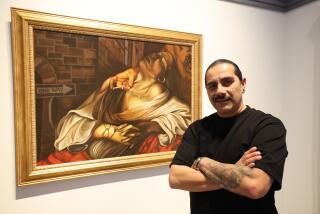On View: José Bedia’s spiritual and physical journeys
“Many things come to me in my trips,” says artist José Bedia. “I see myself as a kind of anthropologist. I do field work, I collect things and take notes — and then the ideas start to come out.”
The ideas pour out in his powerful, outsize drawings, paintings and installations, which are full of references to his physical and spiritual journeys. Nearly 30 of his pieces are being presented in “Transcultural Pilgrim: Three Decades of Work by José Bedia,” at the Fowler Museum at UCLA from Sept. 18 to Jan. 8.
The show has been organized according to major journeys in Bedia’s adult life, says art historian Judith Bettelheim, who curated the exhibition along with Janet Catherine Berlo, a professor at the University of Rochester in New York state. The first gallery features Cuba, the land of Bedia’s birth, and his initiation into Palo Monte, a Cuban religion with African roots. “Mama Wants Blood, Blood of His Bull,” an acrylic painting from 1988, focuses on a man’s sinuous torso, his slender hands holding an empty caldron in front of his solar plexus. The caldron or nganga is given to every initiate of Palo Monte and is meant to be filled with objects important to him. Marks on the upper arms and shoulder are from the initiation rite.
Nearby, the large drawing “If There Is No Sun in My Country I Jumps to the Other Side,” from 1991, shows the major journey Bedia took in leaving Cuba for Mexico. (Two years after that, he moved to the United States; he currently lives in Miami.) Here, a lanky nude male figure takes a giant stride between two shores, a river or canal between them. He brings only his most valuable possession, his nganga. “It’s an artist ready to leave his country and go to the other place,” Bedia, 52, said in a by phone. “It’s a self-portrait in some ways.” The man has a round head with a pointy nose, and he appears throughout the artist’s work, representing both Everyman and the artist.
The second gallery focuses on the artist’s experiences in the Americas, which include learning about Lakota, Peruvian and Mexican spiritual practices. The third area is devoted to his African voyages, where he explored Central African spiritual practices. “It’s art that references religion, but it’s not religious art,” says Bettelheim. “It’s spiritual. The religious references are here as well as the political references.”
Bedia recently came to Los Angeles to paint a 25-foot-wide canvas that will be the backdrop for an installation commissioned by the museum, “Figure Who Defines His Own Horizon Line.” He uses his gloved hands to paint murals, dipping them into the paint, then using them like giant brushes. On the left of the mural is a large head — again, his Everyman — from whose mouth an arm extends. A bronze sculpture of a man with horns, a trickster figure, will be holding a long stick with which he is drawing the image on the wall. And yet this man is not completely free — one leg is chained to a post. In addition, some of the ethnographic material Bedia has collected over the years will be displayed.
Bedia is still traveling, to towns in Mexico for Holy Week and last year to South Africa. “This kind of thing is more important than the idea of an artist sitting inside his studio,” he says.
More to Read
The biggest entertainment stories
Get our big stories about Hollywood, film, television, music, arts, culture and more right in your inbox as soon as they publish.
You may occasionally receive promotional content from the Los Angeles Times.






